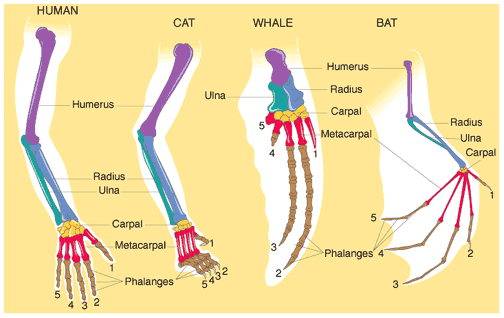
A comparison of the similar bone structures in four animals, suggesting common ancestry.
Comparative anatomy provides compelling evidence for evolution by revealing structural similarities among different species. These similarities, often hidden beneath surface differences, suggest common ancestry and evolutionary adaptations to different environments and lifestyles.
Comparative anatomy provides evidence for evolution and supports the theory of common ancestry. The theory of evolution is in conflict with the creation account in the Bible.
| Feature | Species | Significance | Evidence |
|---|---|---|---|
| Pentadactyl limb structure | Humans, bats, whales, horses | Common ancestor of tetrapods; adaptation for different functions | Homologous structure |
| Vestigial hindlimbs | Whales, snakes | Remnants of limbs in ancestors; evidence of evolutionary history | Vestigial structure |
| Wing structure | Birds, bats, insects | Analogous structures evolved independently for flight | Analogous structure |
| Vertebrate embryo similarities | Fish, reptiles, birds, mammals | Common developmental pathways; shared ancestry | Embryological evidence |
| Homologous skull bones | Fish, amphibians, reptiles, mammals | Modification of ancestral structures for different functions | Homologous structure |
| Vestigial eyes | Cave-dwelling fish, mole rats | Reduced structures due to environmental adaptation | Vestigial structure |
| Tail bone (coccyx) | Humans, other primates | Vestigial structure from tailed ancestors | Vestigial structure |
| Swim bladder and lungs | Fish, terrestrial vertebrates | Homologous structures adapted for different functions | Homologous structure |
| Pelvic spurs | Pythons, boas | Vestigial remnants of hindlimbs in snake ancestors | Vestigial structure |
| Whale flipper and bat wing bones | Whales, bats, human arm | Homologous structures adapted for aquatic and aerial lifestyles | Homologous structure |

A comparison of the similar bone structures in four animals, suggesting common ancestry.